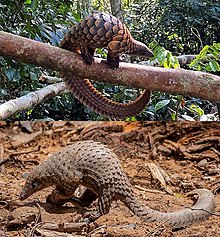| African tree pangolin | |
|---|---|
 | |
| Pangolins from genus Phataginus | |
| Scientific classification | |
| Domain: | Eukaryota |
| Kingdom: | Animalia |
| Phylum: | Chordata |
| Class: | Mammalia |
| Order: | Pholidota |
| Family: | Manidae |
| Subfamily: | Phatagininae Gaubert, 2017 |
| Genus: | Phataginus Rafinesque, 1821 |
| Type species | |
| Manis tetradactyla Linnaeus, 1766 | |
| Species | |
 | |
| Synonyms [2] [3] | |
synonyms of subfamily:
synonyms of genus:
| |
African tree pangolin (Phataginus) is a genus of African pangolins from subfamily small African pangolins (Phatagininae), within family Manidae. [5] Its members are the more arboreal of the African pangolins. [6]
Contents
From 2010 to 2019, at least 895,000 pangolins from the genus Phataginus were illegally trafficked. The animal is hunted and poached for its scales and meat, and is often used in making traditional medicine in places such as China and Vietnam. Attempts to protect these mammals from trafficking and extinction are ongoing; unfortunately their slow reproduction rate stymies population recovery. Currently the tree pangolin is listed as vulnerable. All pangolin species have been listed as vulnerable, endangered, or critically endangered. [7]